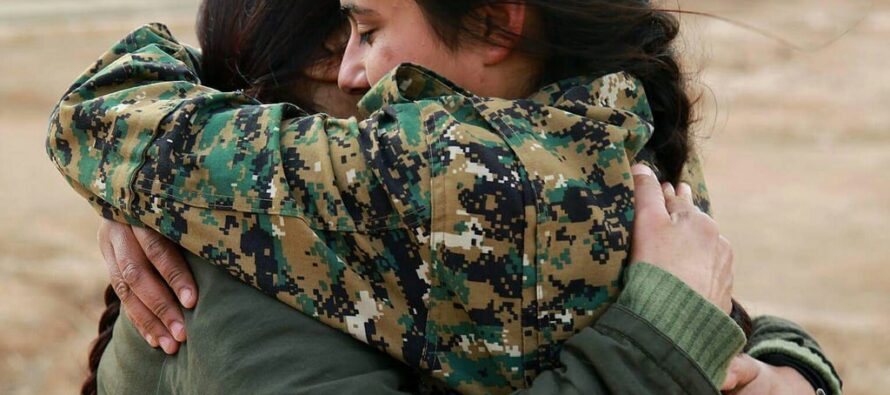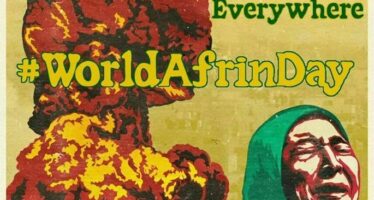Seven years ago, the Rojava Revolution

![]()
The smallest part of Kurdistan, a country divided into four with the 1639 Qasr e Shirin and 1916 Sykes-Picot treaties, Rojava implemented a revolution on July 19, 2012 that would be a ray of hope for the whole Middle East. This part of Kurdistan where Kurdish People’s Leader Abdullah Ocalan worked on for 20 years used the “third way” strategy proposed by Ocalan himself when the day for the revolution came, and has become the revolution of the people in the 7 years since.
After Kurdistan was divided up, Rojava became a backyard for the struggles for freedom in other parts, and the people of Rojava paid a great price for the freedom of Syria. They were always excluded and oppressed by the nation state system. Rojava was divided, robbed of its identity, had its children imprisoned for years, burned to death and murdered. Despite everything, the revolution on July 19, 2012 created a ray of hope for Kurds and all oppressed peoples and faiths.
THE PATH TO REVOLUTION
Looking at the path to revolution and renewing our historical memory could prove to be educational to understand the greatness of today’s revolution and the solution to the Syrian crisis. Because hegemonic ideologies build their hold on power that they think is unshakeable over history they write themselves.
-According to the Sykes-Picot, prepared by the middle of World War I by Britain and France, the Ottoman-occupied Kurdistan’s southern part was allocated to the British and western part to the French.
-With the defeat of the Ottoman Empire, the Malik Faysal government was formed in Syria and Iraq, and its territory included Rojava and Bashur. France, having invaded Lebanon in 1919, invaded Syria in 1920.
-One of the biggest resistance against the French occupation came from a Damascus Kurd, Yusif Ezma. French forces were able to enter Damascus only after Ezma, the leader of the Jaysh al Watani (“The Homeland Army”) was defeated.
-France ruled over Syria for 25 years, only to withdraw when Nazi armies targeted France during World War II. At the head of the resistance against France at the time was another Kurd, Ibrahim Henano from Idlib.
-On April 17, 1946 after the French army withdrew from Syria, Kurds were left without rights or any ownership despite their resistance.
-Syria went through a period of back to back coups in following years. During the Shuqru Quwetli government between 1954-1958, Egyptian President Jamal Abdulnaser took action as Syria was getting closer with Soviet Russia, and Syria and Egypt were united under the name United Arab Republic “against the communist threat”.
-With the Cizire region receiving an intense wave of Kurdish migrants by the late 1950s, with the Kurdish population going over 300.000, the regime ordered a census in Cizire and declared 200.000 Kurds “foreigners”, striping them off their right to citizenship.
In the massacre known to Kurds as the Amude Cinema Massacre of November 13, 1960, hundreds of elementary school children died in the fire in the Amude Cinema as they were watching the Egyptian film Midnight Ghost depicting Algeria’s resistance to France.
-With the United Arab Republic failing in 1963, the Arab nationalist Baath Party took power on March 8, 1963. Baath implemented chauvinistic policies and attempted to “Arabify” all who lived on Syiran lands.
-The Baath Party banned the mother tongue of the Kurds, who had the biggest population in Syria after Arabs, confiscated their lands, banned their organizations, changed the names of their towns and implemented assimilation policies.
-After 7 years of Baath, Hafez Assad took over with an “inter-party coup” in 1971. He imprisoned or exiled his former “friends in the cause”. The new Baath government cracked down even harder on Kurds and completed the “Arab belt” along the Gire Spi and Azaz-Jarablus line.
-The Baath regime implemented a plan similar to Turkey’s Eastern Reform Plan of 1963, outlining a 12 step genocide.
-Before the pain of Kurdish politicians being set on fire in the Heseke prison in 1993 had dulled, the Qamishlo massacre of March 12, 2004 and the serhildans that followed were the first spark for the July 19 Revolution. Kurds started to form their self defense forces.
-Despite all policies of oppression, robbing of identity, arrests, masascres and assimilation, Rojava Kurds continued to organize.
-The Xoybun Society founded in 1927 in Beirut brought Kurds in Cizire, Damascus and Aleppo together. The Xoybun Society organized the uprisings in Agri between 1927 and 1930. Rojava Kurds never shied away from supporting the struggles for freedom in other parts.
-Rojava was also the center for Kurdish enlightenment. Celadet Eli Bedirxan and his brother Kamuran Eli Bedirxan led the first Kurdish journal, Hawar. The foundations for a latinized Kurdish alphabet were also laid at this time.
-The big development for Rojava was when Ocalan crossed into this part of Kurdistan on July 2, 1979. With Ocalan’s arrival at kobane, Rojava was turned into a veritable academy. Hundreds of young Rojavans lunged into the revolution for freedom after graduating from this academy.
-After the Arab Spring rolled in in 2010, in 2011 the bell tolled for Syria.
-In January, Hasan Ali Akleh set himself on fire to protest the regime in Heseke. After the police beat up a shopkeeper in Damascus, 1500 people took to the streets chanting Syrian people can’t be insulted.
-The slogan, “Al Shaab Yurid Isqat Al Nizam”, the people want to tear down the regime, previously heard in Egypt and Yemen now resounded in Daraa, Syria.
-15 students who wrote the slogan on walls were captured and tortured by the regime. The people’s rage against this spread from Daraa to Hama, Homs, Latakia, Qamishlo and Deir Ez Zor. Later, Friday Rage became a regular protest.
-13 year old Hamza Al Hatip had been arrested at a protest in April and was tortured severely for a month. On May 25, his body was delivered to his family with burns and three bullet wounds. Hatip’s photographs were shared on social media, which lead to an explosion of rage.
-By June, the armed wing of the struggle started to form. 300 Syrian opposition members met in Antalya, Turkey on June 2 and held the “Change in Syria Conference”. A committee of 31 people was formed after the conference.
-The conference led by the Ikhwan-i Muslim (the Muslim Brotherhood) resulted in the formation of the Free Syrian Army (FSA). on October 11, the FSA’s political wing founded the Syrian National Council (SNC).
-In 2012, Al Qaeda leader Ayman Al Zawahiri published a video calling “Muslims” to jihad in Syria.
-On April 12, 2012, the “peace talks” the United Nations (UN) conducted in the country were declared as failed. On June 13, the UN called the situation in the country a “civil war”.
-As July 19 rolled in, with FSA taking over Azaz, Manbij and Jarablus, the Rojava Democratic Movement (TEV-DEM) started to take over control, starting with Kobane. Their strategy was called the “third way”: Not the regime, but not the opponents of the regime either.
-With the democratic autonomy Kurds declared together with Arabs, Armenians. Syriacs, Turkmens and Circassians in Rojava, the region was the most peaceful in Syria for a long time. But attacks against the region never truly stopped.
-The peoples of the region were organizing the democratic autonomous system on one hand, and on the other fighting against the ruthless attacks against their lands.
-Gangs backed by the Turkish state, acting under al-Nusra and FSA, were defeated in Afrin’s Qestel Jindo district as well as Aleppo’s Sheikh Maqsoud and Serekaniye districts. The Turkish state then put forth ISIS.
-The 2014 ISIS attack against Kobane was the beginning of the end for the group. They drew their last breath on March 21, 2019 in Deir ez-Zor’s Baghouz village.
-SDF Commander General Mazlum Ebdi announced that Kurds and peoples of the region sacrificed over 11.000 of their children to defend their revolution.
-The social, political, diplomatic, financial and women’s liberation system is not confined to Rojava, and grows every day in its claim to be a solution for Syria and the whole region.
Related Articles
24 March 2018, Global Action Day for Afrin
![]()
Joint Statement of the International Campaign in Defense of #Afrin
Turkish military attacks PKK camps in Iraq for 2nd day
![]()
TODAYSZAMAN Turkey has continued a heavy air and artillery assault with 16 warplanes on the outlawed Kurdistan Workers’ Party (PKK)
Prisoners on hunger strikes for books
![]()
The administration of Tekirda? F Type Prison No 1 imposed a book restriction on inmates on 15 January 2013 which



